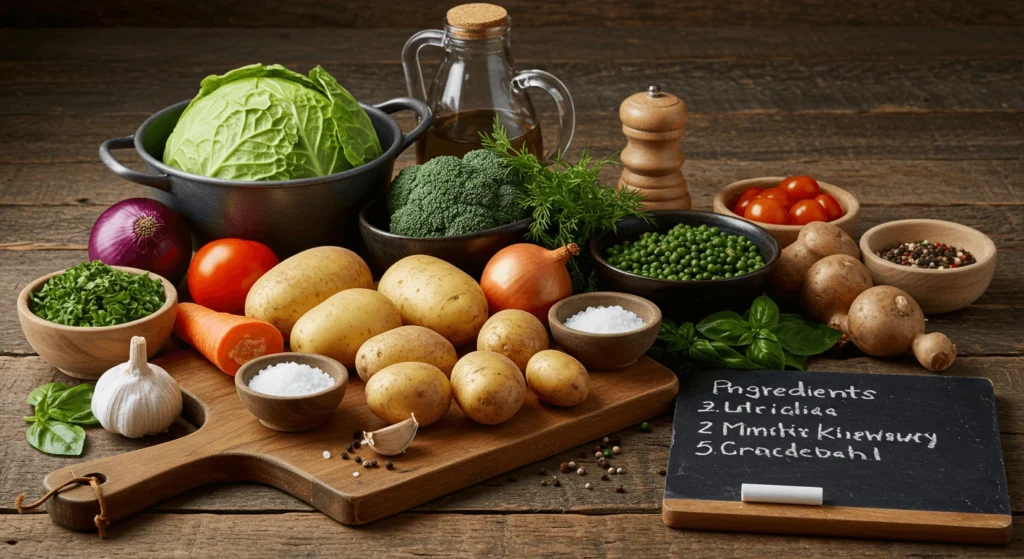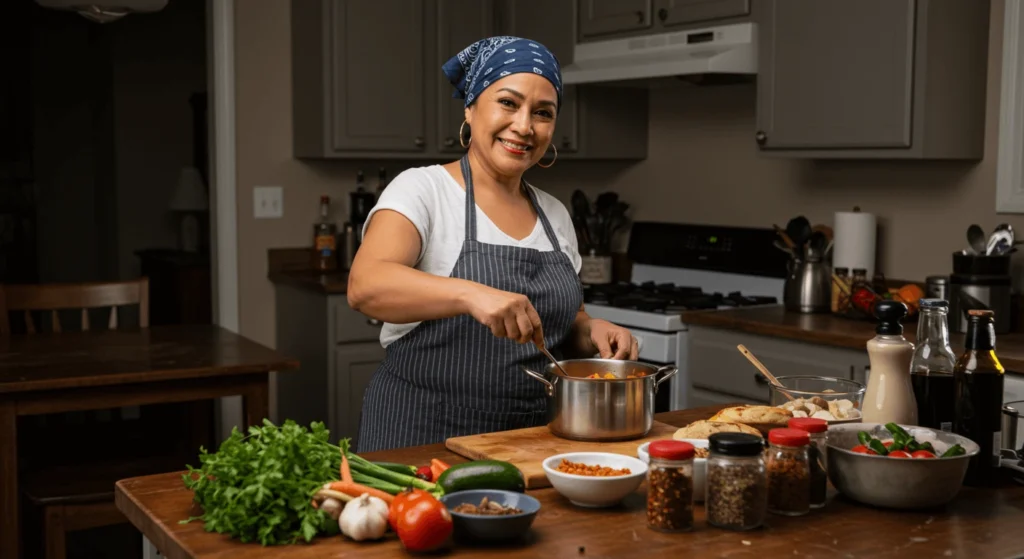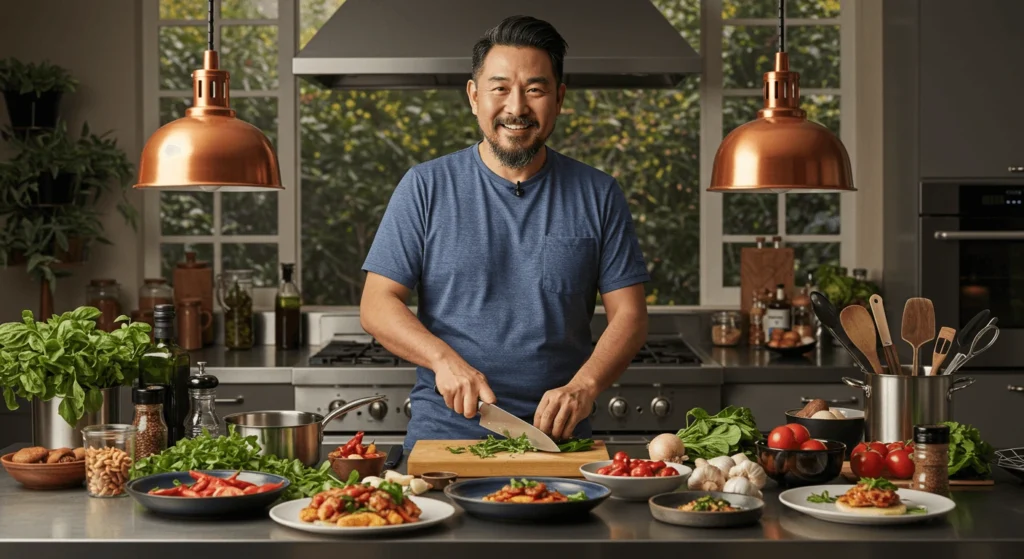Cooking is a cornerstone of self-sufficiency, yet it often feels like a daunting challenge for those just starting out. Whether you’re living on your own for the first time or simply want to learn how to prepare wholesome meals, cooking is a valuable life skill that goes beyond just feeding yourself. It fosters creativity, promotes healthier eating habits, and saves money.
Many beginners face the fear of failure or the misconception that cooking requires innate talent. This guide is here to help you overcome those fears with a clear, step-by-step approach to simple, satisfying recipes. By the end, you’ll be armed with knowledge, tools, and confidence to take on the kitchen.
Table of Contents
Why Step-by-step Recipes Are Ideal for Beginners

Breaking Down Complexity: The Value of Clear Instructions
Cooking can seem overwhelming when recipes use jargon or skip crucial details. Step-by-step recipes simplify the process by guiding you through each task, from preparing ingredients to plating the final dish. This clarity ensures you understand not just what to do, but why it matters.
How Step-by-step Recipes Eliminate Guesswork
For beginners, uncertainty is often the biggest obstacle. Precise instructions in step-by-step recipes remove ambiguity, making it easier to replicate results. Measurements, timings, and even visuals help you follow along without second-guessing.
Building Confidence Through Small, Achievable Wins
Each successful recipe you complete is a confidence boost. Starting with simple dishes allows you to master basic techniques, laying a strong foundation for more complex cooking. Small victories inspire you to keep experimenting and expanding your culinary repertoire.
Essential Kitchen Basics Every Beginner Needs to Know

Must-have Tools for a Well-equipped Beginner’s Kitchen
The right tools can make or break your cooking experience. Start with essentials like a chef’s knife, cutting board, non-stick skillet, saucepan, and mixing bowls. Add measuring cups, a whisk, and a spatula for versatility.
Budget-friendly Tips for Stocking Your Kitchen
You don’t need to splurge to get started. Look for quality tools at discount stores or online sales. Multi-purpose items, like a skillet that works for frying and sautéing, are ideal for saving money.
How to Set Up an Organized and Functional Cooking Space
An organized kitchen improves efficiency and reduces stress. Group similar items together—store spices in one area, utensils in another. Keep your workspace clean and uncluttered to make cooking enjoyable.
Ingredient Essentials: The Foundation of Simple Cooking


A well-stocked pantry is the cornerstone of effortless cooking. Ingredient essentials such as rice, pasta, canned beans, and olive oil provide versatility and ensure you’re always ready to whip up a meal. Fresh ingredients like eggs, seasonal vegetables, and herbs elevate dishes with vibrant flavors. These staples form the foundation of balanced and delicious meals. For simple cooking, focus on high-quality basics that can be combined in countless ways. Substituting missing items, like swapping yogurt for sour cream, ensures flexibility without sacrificing taste. Mastering these essentials empowers you to create flavorful, nourishing dishes with confidence and ease.
Fresh Ingredients to Keep on Hand for Versatile Meals
Keeping a selection of fresh ingredients on hand is essential for crafting versatile meals that cater to any craving. Eggs, a protein-packed staple, can transform into omelets, quiches, or baked goods. Seasonal vegetables like spinach, bell peppers, and zucchini add color and nutrition to dishes while adapting to countless recipes. Fresh herbs such as basil, parsley, or cilantro elevate flavors and bring a touch of elegance to even the simplest meals. Citrus fruits like lemons and limes offer a bright, tangy kick, perfect for marinades or dressings. With these essentials, you can create vibrant, adaptable meals with ease and creativity.
Substitution Secrets: What to Do When You’re Missing an Ingredient
Cooking doesn’t have to come to a halt when you’re missing an ingredient. Mastering substitution secrets allows you to adapt recipes seamlessly. Out of buttermilk? Combine milk with a splash of lemon juice or vinegar. No eggs? Applesauce or mashed bananas can work wonders in baking. Replace sour cream with plain yogurt for a lighter twist. Missing breadcrumbs? Crushed crackers or oats can step in. Even herbs can be swapped—use dried versions when fresh isn’t available. These simple yet ingenious substitutions not only save time but also encourage creativity, turning potential setbacks into opportunities for culinary experimentation.
Breakfast Recipes: Starting the Day with Confidence
Perfecting Scrambled Eggs: A Beginner’s Ultimate Guide
Perfecting scrambled eggs is an essential skill, and this beginner’s ultimate guide will help you achieve creamy, fluffy perfection every time. Start by cracking fresh eggs into a bowl and whisking them thoroughly with a pinch of salt to ensure a uniform texture. Heat a non-stick pan over low heat and add a knob of butter, allowing it to melt gently. Pour in the eggs and stir continuously with a spatula, ensuring slow, even cooking. Remove from heat just before they’re fully set, as residual heat will finish the job. The result? Silky, delicious scrambled eggs that are effortless yet impressive.
Pancakes Made Simple: Fluffy, Golden, and Foolproof
Creating pancakes simple, yet irresistibly fluffy, golden, and foolproof, is easier than you think. Start by whisking together flour, baking powder, sugar, and a pinch of salt for the perfect dry mix. In a separate bowl, combine milk, eggs, and melted butter, then blend the wet and dry ingredients until just combined lumps are okay! Heat a non-stick skillet over medium heat and lightly grease it. Pour batter into the pan, watching for bubbles to form before flipping for that golden perfection. The result is light, airy pancakes with a soft texture, ready to be topped with syrup, fruit, or butter.
Smoothies for Beginners: Quick, Nutritious, and Endlessly Customizable
Smoothies for beginners are the perfect blend of convenience and nutrition. They’re quick, nutritious, and endlessly adaptable to suit your taste. Start with a base—milk, yogurt, or plant-based alternatives. Add a handful of frozen fruits like berries or mango for natural sweetness. Incorporate greens like spinach or kale for an extra boost of vitamins, and enhance flavor with a dash of cinnamon or vanilla. For added creaminess, throw in a banana or avocado. Blend until silky smooth, and you’ve got a wholesome drink ready in minutes. With countless combinations, smoothies make healthy eating both simple and delicious for any beginner.
Easy Lunch Ideas for New Cooks
When you’re just starting out in the kitchen, easy lunch ideas are your best friend. For new cooks, simplicity is key, but flavor should never be compromised. A classic grilled cheese sandwich can be elevated with a touch of pesto or tomato slices. A quick pasta with olive oil, garlic, and a sprinkle of parmesan makes for a satisfying meal. For something lighter, toss together a fresh salad with mixed greens, nuts, and a tangy vinaigrette. These simple, adaptable dishes require minimal ingredients yet deliver maximum satisfaction. With just a few basic techniques, you’ll be creating lunches that feel gourmet every time.
A No-fail Guide to Pasta with Tomato Sauce
This guide to pasta with tomato sauce is perfect for anyone seeking a quick, satisfying meal. Begin by cooking pasta until al dente, reserving a bit of the starchy water for later. In a pan, sauté minced garlic and onions in olive oil until fragrant. Add canned or fresh tomatoes, seasoning with salt, pepper, and a pinch of sugar to balance acidity. Let the sauce simmer, stirring occasionally to enhance its richness. Toss the drained pasta into the sauce, adding a splash of the reserved water for a silky texture. Garnish with fresh basil and Parmesan, and enjoy an effortless culinary classic.
Crafting Fresh and Flavorful Salads with Minimal Effort
Creating flavorful salads doesn’t have to be time-consuming. Start with a base of crisp greens like arugula, spinach, or romaine for texture and freshness. Add layers of color and taste with cherry tomatoes, shredded carrots, or sliced cucumbers. For protein, include grilled chicken, chickpeas, or boiled eggs. Enhance the flavor profile with a sprinkle of nuts, seeds, or crumbled feta cheese. The key to elevating your salad lies in the dressing—whisk together olive oil, lemon juice, Dijon mustard, and a touch of honey for a tangy, homemade vinaigrette. With minimal effort, you can enjoy vibrant and satisfying meals every time.
Dinner Recipes That Impress Without Stress
When it comes to dinner recipes, simplicity doesn’t have to mean sacrificing flavor. A one-pan roasted chicken with vegetables is the perfect stress-free meal—tender chicken, caramelized vegetables, all cooked in one go. For an effortless yet elegant dish, try a classic spaghetti with meatballs, where you can easily control the ingredients for a healthier twist. Stir-frying offers another quick option, allowing for endless variations of proteins and vegetables in a vibrant, flavorful dish. These dinner recipes are designed to impress without overwhelming you, turning every meal into a satisfying, delicious experience with minimal fuss.
One-pan Roasted Chicken and Vegetables: A Beginner’s Dream Dish
Roasted chicken with vegetables is the epitome of simplicity and flavor, making it a beginner’s dream dish. Start with bone-in chicken thighs for tender, juicy meat. Toss them with olive oil, salt, pepper, and aromatic herbs like rosemary or thyme. Add an assortment of root vegetables carrots, potatoes, and onions—for a hearty, colorful base. Spread everything on a single sheet pan and roast in the oven at 400°F until the chicken is golden and the vegetables are caramelized. The result is a flavorful, balanced meal with minimal prep and cleanup. This dish proves that impressive cooking can be effortless.
Spaghetti and Meatballs Simplified: Classic Comfort Food
Spaghetti and meatballs simplified is the ultimate classic comfort food, perfect for any occasion. Start by combining ground beef with breadcrumbs, egg, garlic, and Parmesan to form tender meatballs. Sear them in a skillet until golden brown, then simmer in marinara sauce to infuse rich flavors. Meanwhile, cook spaghetti until al dente, ensuring the perfect texture to hold the sauce. Toss the pasta in the savory tomato mixture, letting it soak up every ounce of flavor. Serve with a sprinkle of fresh parsley and extra Parmesan for a heartwarming dish that’s easy to prepare yet feels indulgent.
Stir-frying 101: Quick, Healthy, and Packed with Flavor
Stir-frying is a culinary technique that delivers quick, healthy, packed with flavor meals in mere minutes. The key is high heat and constant stirring, which seals in nutrients and enhances the taste of every ingredient. Start by heating a wok or skillet, then add a splash of oil for sautéing garlic and ginger. Toss in your choice of lean protein—chicken, tofu, or shrimp—followed by vibrant vegetables like bell peppers, broccoli, and snap peas. A splash of soy sauce or a drizzle of sesame oil adds depth. The result is a dish that’s both nourishing and bursting with flavor, all in one fast, sizzling step.
Tips for Simplifying the Cooking Process

Time-saving Meal Prep Strategies for Beginners
Prepare ingredients like chopped vegetables or marinated meats in advance. Store them in airtight containers to make weeknight cooking faster.
How to Multitask Effectively in the Kitchen
Learn to coordinate tasks, such as boiling water while chopping vegetables. This skill minimizes downtime and keeps your cooking efficient.
Keeping Your Kitchen Clean and Organized as You Cook
Clean as you go to avoid a daunting mess at the end. Wash utensils and wipe counters between steps for a smoother cooking experience.
Troubleshooting Common Beginner Mistakes
Avoiding Overcooking or Underseasoning Your Dishes
Use timers to prevent overcooking, and taste-test throughout the process to adjust seasoning. These simple habits ensure better results.
Why Reading Recipes Thoroughly Matters
Skipping steps often leads to mistakes. Read the entire recipe before starting to avoid surprises and stay prepared.
Quick Fixes for Common Cooking Mishaps
Too salty? Add a starch like rice or potatoes to absorb excess salt. Burned food? Remove charred bits and salvage what’s edible.
Building Your Confidence in the Kitchen

How to Experiment with Flavors Once You’ve Mastered the Basics
Start adding your own twist to recipes. Try new herbs, spices, or ingredients to personalize dishes and develop your cooking style.
The Role of Practice in Developing Your Cooking Skills
Cooking is like any other skill—it improves with repetition. The more you cook, the more natural and enjoyable it becomes.
Learning to Enjoy the Process, Not Just the Result
Appreciate the journey of cooking. The smells, textures, and creativity involved can be as rewarding as the meal itself.
Conclusion
Cooking for beginners is a journey of discovery and empowerment. Each step, from mastering simple recipes to exploring new techniques, builds your confidence and skills. With a strong foundation of step-by-step recipes, you’re prepared to tackle more complex dishes and even create your own culinary masterpieces.
So, embrace the process, savor the learning, and enjoy the delicious results. Your kitchen adventure starts now one recipe at a time!

